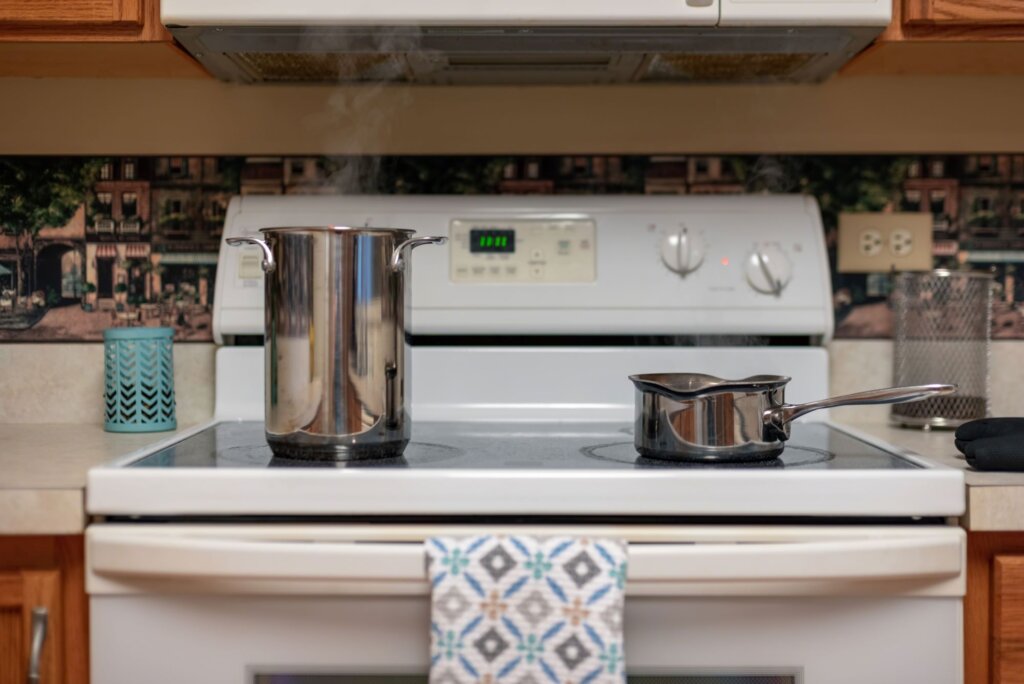When it comes to cooking, the heart of your kitchen is undoubtedly the stove. It’s where you simmer sauces, sear steaks, and whip up culinary masterpieces. But with various options available, how do you choose the right stove for your cooking needs at home? Let’s explore the key differences between electric, gas, induction, and dual fuel ranges.
Electric Stove
Electric stoves are a popular choice for many homeowners due to their affordability and ease of use. These stoves may feature removable coil burners and drip pans or boast a flat cooking surface that’s a bit easier to clean. With even oven heat, electric stoves are more than suitable for everyday cooking and baking tasks—but they may be more prone to uneven stovetop heat. While they may have a slightly slower heat response compared to gas or induction, electric stoves remain a reliable and budget-friendly option for home cooks who value simplicity and efficiency in their cooking routines.
Pros:
- Affordable: Electric stoves are typically less expensive to purchase and install.
- Smooth Surface: Electric stoves with smooth surfaces are easy to clean and offer a sleek look.
- Consistent Heat: Consistent oven heat makes them a great option for baking.
Cons:
- Slower Heat Response: Electric stoves take longer to heat up and cool down, which can affect cooking precision.
- Limited Temperature Control: They may not offer the same level of temperature control as gas or induction.

Gas Stove
Natural gas stoves are coveted by passionate home cooks for their exceptional control over cooking temperatures. These stoves feature open flames that provide instant heat adjustment, allowing you to fine-tune your cooking with precision. The even heat distribution on the stovetop makes gas stoves perfect for tasks like searing, stir-frying, and sautéing. However, gas stoves often require professional installation and can be a bit more challenging to clean due to their burner grates and caps. Gas ovens also tend to suffer from uneven heat or hot spots, which make them less reliable for baking than other types of ovens. For home cooks who value precise stovetop control and enjoy the speed and flexibility of gas, these stoves are an excellent choice.
Pros:
- Precise Temperature Control: Gas stoves offer instant heat adjustment, making them a favorite among home chefs who desire precise temperature control.
- Even Cooking: The open flame provides even heat distribution, ideal for tasks like searing and stir-frying.
Cons:
- Installation Requirements: Installing a gas line can be costly if your home isn’t already equipped.
- Cleaning Challenges: Gas burners can be harder to clean due to the grates and burner caps.
- Intense heat: For people with less experience with gas stoves, the heat can be a little intense or difficult to control at first.
- Safety: If gas stoves are turned on without a flame, they can fill your home with natural gas and cause carbon monoxide poisoning. Natural gas is also highly flammable (hence why it is used for open-flame stovetops), and leaked gas can cause an explosion if there is so much as a spark.
Induction Cooktop
Induction cooktops represent new technology in the world of cooking. Unlike traditional stoves, these cooktops don’t rely on open flames or hot coils to generate heat. Instead, they use magnetic fields to directly heat the base of your cookware. This method results in rapid and precise heating, similar to gas stoves. Induction cooktops also offer great energy efficiency, as they heat only the cookware’s base and not the surrounding surface—making them an eco-friendly choice for your home kitchen.
Perhaps the most notable feature is their safety; the stovetop surface stays cool to the touch, reducing the risk of burns. However, for induction to work in your home kitchen, you’ll need cookware with magnetic bottoms. While these stoves may be more expensive upfront, their energy efficiency often leads to long-term savings.
Pros:
- Rapid Heating: Induction cooktops heat up quickly and offer precise temperature control, similar to gas.
- Energy Efficiency: They are highly efficient, as they use electromagnetic energy to heat only the cookware’s base, not the surrounding surface.
- Safety: Induction cooktops stay cool, reducing the risk of burns.
Cons:
- Cookware Compatibility: You’ll need compatible cookware with magnetic bottoms for induction to work.
- Cost: Induction stoves can be more expensive upfront, but their energy efficiency can lead to long-term savings.
Dual Fuel Ranges
Dual fuel ranges combine a gas stovetop with an electric oven, offering the best of both worlds. This option is excellent for home cooks who want the precise control of gas for stove cooking and the even heat of electric ovens for baking.
Pros:
- Precise Cooking Control: Dual fuel ranges offer the precise temperature control of gas stovetops, allowing you to fine-tune your cooking to perfection.
- Even Baking: Electric ovens in dual fuel ranges provide consistent and even heat distribution, ideal for baking and roasting in your home kitchen.
- Versatility: You get the best of both worlds—the speed and flexibility of gas stovetops and the reliability of an electric oven.
Cons:
- Higher Initial Cost: Dual fuel ranges tend to be more expensive upfront compared to either gas or electric stoves.
- Professional Installation: Installation may require the services of a professional to connect both the gas and electric components.
Choosing the Right Stove for You
When it comes to choosing the right stove for your home kitchen, there are options tailored to various cooking styles and needs. Your ultimate selection should align with your cooking preferences, budget considerations, and the setup of your kitchen. With all things considered, choose the stove that will be your trusted culinary companion for years to come.
